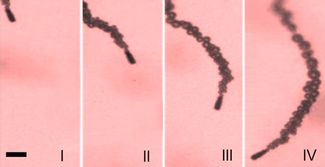Bubble Propelled Microbots
|Researchers fed mice a small drop of a liquid. Inside the drops, invisible to the naked eye, were thousands of tube-shaped, microscopic motors. The motors made their way to the mice’s stomachs, embedded in their stomach linings, and released their tiny payloads: nano-size flakes of gold. The research represented a major step toward putting microbots to work in human medicine, where they could one day ferry drugs efficiently into specific organs or even specific cells.
“Six hours after getting their drops, the UCSD mice didn’t seem to have any damage in their stomach linings, showing that it could be safe for animals to ingest micro-motors. In addition, the UCSD researchers found more gold flakes stayed in the mice’s stomach walls when they swallowed motors than when they swallowed the gold nanoparticles by themselves. That shows moving motors could be an improved way of getting medicines to stick to bodily tissues, compared to drug molecules, which flow through the body more passively.
So how do micro-motors work? They’re not exactly like your average car or lawnmower. Their size and the watery conditions they work in aren’t conducive to internal combustion. Instead, many depend on chemistry on their surfaces to propel them along. In the case of the UCSD motors, contact with acids, like those found in the digestive system, moves them around. The motors are made of zinc, which reacts with gastric acid to make propulsive hydrogen bubbles. Videos researchers recorded of their motors showed them zooming around with a puffy trail of bubbles behind them. They move at 60 micrometers a second, or about an inch every seven minutes.”
